A Captured Sword and Lost Story of the Battle of Stones River
In November 1900,R.A. Miller, formerly a Confederate line officer, wrote a short note to thelocal newspaper editor advertising for the return of a sword he had capturedduring the Civil War. “I have a sword captured in the battle of Murfreesboro onthe 31st of December 1862,” he wrote. “The name on the scabbard isI. Abernathy, lieutenant, 37th Indiana Volunteers. I was woundedseverely a few minutes after. I was a lieutenant in command of Co. B, 24thMississippi Volunteers. The sword will be returned on application of partiesinterested.”
To start off, who was Lieutenant R.A.Miller of the 24th Mississippi, and how did he come to be wounded onthe battlefield of Stones River? And who was I. Abernathy of the 37thIndiana and what was his fate? Let’s explore those questions a bit.
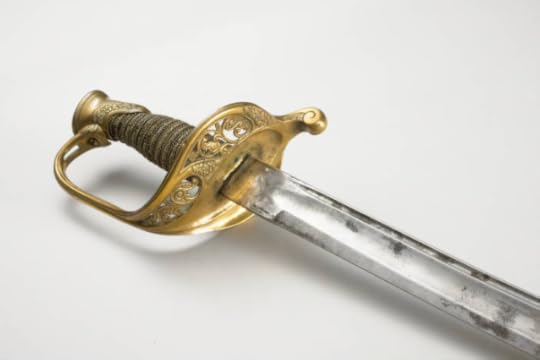 We don't know for sure exactly what type of sword Lieutenant Abernathy was carrying at Stones River but the type most commonly carried was the Model 1850 Foot Officer's Sword like the one pictured above. The lieutenant's sword was engraved with his name and regiment.
We don't know for sure exactly what type of sword Lieutenant Abernathy was carrying at Stones River but the type most commonly carried was the Model 1850 Foot Officer's Sword like the one pictured above. The lieutenant's sword was engraved with his name and regiment. The Index to Compiled Confederate Military Service Recordsshows that Robert A. Miller enlisted as a private in Co. B of the 24thMississippi but has no further record. Co. B had a company monicker of the “MississippiConfederates;” every company in the regiment had a monicker ranging from the Co.H who called themselves the “Buena Vista Hornets” to Co. E who were the “HelenJohnstone Guards.” The regiment was raised in response to Governor John J. Pettus’scall for three-years enlistment and was “made up largely of very young men. Thecompanies were assembled at Marion Station and mustered into the ConfederateStates service in September and October 1861.”
Fortunately, Fold3 has Lieutenant Miller’s complete servicefile which shows he enlisted August 27, 1861, at West Point, Mississippi andwas promptly promoted to orderly sergeant. By February 12, 1862, he waspromoted to third lieutenant (a rank not typically found in the Union army) andby the time of Stones River was a second lieutenant and apparently in commandof Co. B.
The 24th Mississippi was a well-traveled regimentby the time of Stones River. Shortly after mustering into service, it wasordered to report to General Robert E. Lee’s command at Savannah, Georgia onthe Atlantic coast. “As they were enlisted for the war, General Lee gave themarms intended for Georgia,” a Confederate history noted. “In December, GeneralLee ordered the regiment to Fernandina [Florida] which was exposed to Federalnaval expeditions. The abandonment of the coast soon followed and the 24thwas ordered in late February 1862 to Tennessee. They were not able to start onaccount of limited railroad transportation until late in March. On March 31st,it was ordered detained at Chattanooga with the command of General Samuel B.Maxey.” On April 9th (in the wake of the losses at Shiloh), Maxey’scommand which included the 41st Georgia and 9th Texas wasordered to Corinth where it joined the Army of Mississippi, the predecessororganization to the Army of Tennessee which fought at Stones River.
The regiment would serve in the Army of Mississippi/Tennesseefor the remainder of the war. At the end of May, the army abandoned Corinth andwent into camp near Tupelo, Mississippi to recuperate and reorganize. Now underthe command of General Braxton Bragg, in late July the army moved via railroadand steamboat from Mississippi to Chattanooga, Tennessee. By early September,the army marched into Kentucky. The 24th Mississippi formed part ofColonel Thomas M. Jones’ brigade during the Kentucky campaign.
By the time of Stones River, the 24th Mississippiwas in a new brigade under the command of Colonel Edward Walthall, servingalongside the 45th Alabama, 27th Mississippi, 29thMississippi, and 30th Mississippi, the 10th MissouriBattery and one very late addition, the 39th North Carolina whichjoined the brigade on January 1, 1863, in part to make up for the heavy lossesincurred on December 31. Just a few days before the battle, Brigadier GeneralJ. Patton Anderson assumed command of the brigade while Colonel Walthallreturned home to Mississippi to attend to his sick wife.
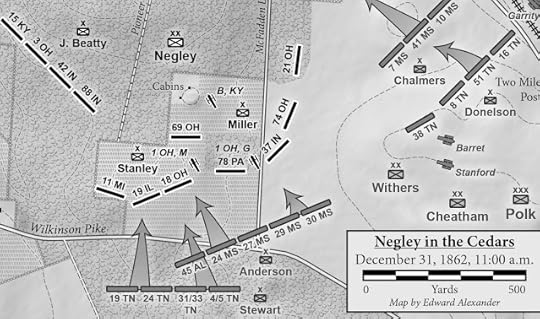 The 24th Mississippi was the left center regiment in Anderson's brigade line at Stones River. Moving in conjunction with the neighboring 45th Alabama, the Mississippians first clashed with portions of Sheridan's division before moving into the cedars and tangling with the two brigades of General James Negley's division of Thomas's Corps.
The 24th Mississippi was the left center regiment in Anderson's brigade line at Stones River. Moving in conjunction with the neighboring 45th Alabama, the Mississippians first clashed with portions of Sheridan's division before moving into the cedars and tangling with the two brigades of General James Negley's division of Thomas's Corps. “The brigade went into line of battle on December 28, 1862,on the left of Chalmers' Brigade, stretching on the right into a dense cedarforest,” a Confederate history reported. “The regiment threw up breastworks ofthe loose stone which covered the ground. The skirmishers were engaged throughthe next two days, and on the 31st the attack began."
Lieutenant Colonel Robert McKelvaine provided some furtherdetails in his after-action report. “The regiment was ordered about 8 a.m. inconnection with the 45th Alabama to support the right of Colonel Manigault’sbrigade and in the event Colonel Manigault’s brigade failed to take a batteryon the right-hand side of the Nolensville Pike in a small prairie or old field,my regiment in connection with the 45th Alabama was to charge thebattery which I did. The first charge my regiment advanced as far as the pikeand I observed that my support on the left was giving way and I here ordered mymen to fall back which was done in good order.”
“A second charge was made and again I wascompelled to fall back for the reason above stated,” McKelvaine continued. “Athird charge was made in which we were successful in taking the battery, theenemy fleeing before us through a small field to a thick cedar grove where theymade a stand for a short time. At this place, I had two men killed and severalwounded. Very soon the ever-memorable General Patton Anderson dashed in frontof my line with his hat off calling for the Mississippians to follow him, whichthe regiment did in good order and new reinforcements joined in the pursuit,the enemy completely demoralized.” [The battery mentioned was Battery G of the1st Ohio Light Artillery which lost several guns in this sector ofthe field.]
As the 24th Mississippi surged north of theWilkinson Pike, the remnants of Sheridan’s division fell back through thecedars before them, unmasking the right flank of General James Negley’sdivision. The right flank brigade under Colonel Timothy Stanley soon started tofall back which exposed the left flank brigade under Colonel John F. Miller, whosecommand included the 37th Indiana. It was at this point, somewherein the cedars near Tour Stop #2 on the present Stones River National Battlefield,that Lieutenant Miller captured Lieutenant Abernathy’s sword.
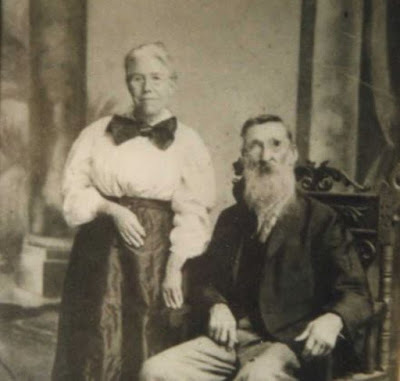 Second Lieutenant Robert A. Miller of Co. B, 24th Mississippi seated beside his wife Martha in an image likely dating from around 1900, the same time that he was trying to reunite Lieutenant Abernathy's sword with his family or comrades. Severely wounded shortly after recovering the sword on the battlefield, Miller would spend most of the next two years in various hospitals before being discharged in December 1864.
Second Lieutenant Robert A. Miller of Co. B, 24th Mississippi seated beside his wife Martha in an image likely dating from around 1900, the same time that he was trying to reunite Lieutenant Abernathy's sword with his family or comrades. Severely wounded shortly after recovering the sword on the battlefield, Miller would spend most of the next two years in various hospitals before being discharged in December 1864.In a January 21, 1863, report of thecasualties sustained by Walthall’s Brigade during the campaign, LieutenantMiller is listed as being severely wounded in the leg around noon on December31, 1862, and “near the cedar thicket.” A casualty list crafted by AdjutantW.W. Robinson and shared with the Mobile Advertiser & Registerconfirms this fact. He was sent to the hospital and apparently went South withthe army when they retreated from Murfreesboro in the early morning hours ofJanuary 4, 1863. Subsequent records make it clear that he was sent to thehospital in Columbus, Mississippi and despite months of recuperation, was neverable to return to duty. Consequently, he was retired December 7, 1864, andcleared from the rolls of the 24th Mississippi.
A quick check of Find-A-Grave revealedthat Robert Andrew Miller was born February 27, 1833, in Lynchburg, Virginia,and moved to Mississippi in the 1850s. On August 4, 1859, he married his wifeMartha Jane McDowell (a 17-year-old South Carolinian) with whom he had sixchildren: William McDowell Miller born in 1860, Sarah Duncan “Sallie” Miller in1864, Robert Esmond Miller in 1869, Margaret Elizabeth Miller in 1872, PowhatanStaples Miller in 1875, and Agnes D. Miller in 1878. The 1860 Federal censusshows Miller and his wife residing at Starkville, Oktibbeha County, Mississippiwhere he was working as a house carpenter. Lieutenant Miller lived a long and active lifeas a farmer despite his wound, passing away July 22, 1911, in West Point,Mississippi at the age of 78. He is buried at Greenwood Cemetery in West Point.
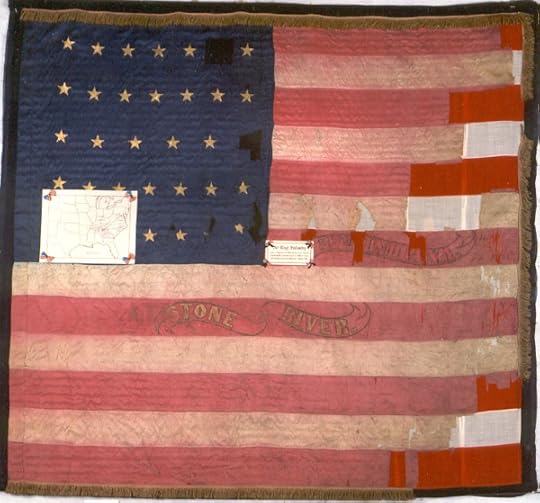 The national colors of the 37th Indiana may have been the last thing Lieutenant Abernathy saw on the battlefield at Stones River. The colors above carry the single honor for Stone River, the regiment's first severe engagement and its costliest of the Civil War. My great-great grandfather was there, fighting in the ranks of Co. D.
The national colors of the 37th Indiana may have been the last thing Lieutenant Abernathy saw on the battlefield at Stones River. The colors above carry the single honor for Stone River, the regiment's first severe engagement and its costliest of the Civil War. My great-great grandfather was there, fighting in the ranks of Co. D. Who was I. Abernathy of the 37thIndiana? A quick check of the Report of the Adjutant General of the State ofIndiana reveals that it was First Lieutenant Isaac Abernathy of Co. K. Aresident of Knightstown, Rush County, Indiana, he was commissioned as a second lieutenantin Co. I on September 10, 1861, and was promoted to first lieutenant and transferredto Co. K on November 24, 1861. He was killed in action December 31, 1862, atStones River and was later buried at Mount Union Cemetery in Union Township,Ross County, Ohio. He was a bachelor.
Unfortunately, I have been unable tofind a more specific account detailing the circumstances of LieutenantAbernathy’s death; this letter from Sergeant William R. Hunt of Co. K providingthe best description. “About 9 o’clock a.m., General Negley’s division becameengaged and the 37th Regiment went into the fight about that time.Our company went in with 46 men besides the captain and Lieutenant Abernathy.We fought them about half or three quarters of an hour. We were then ordered tofall back as the enemy were about to outflank us. They were then pouring a hotfire into us from the front and back flanks. We lost 19 of our company killedand wounded, namely the killed being Lieutenant Abernathy and A.B. Kirkham.”
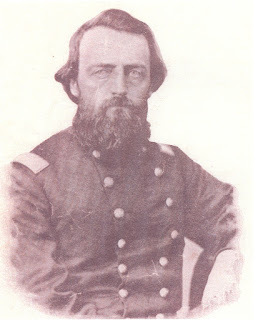 Lt. Col. William D. Ward
Lt. Col. William D. Ward37th Indiana
It wasn’t until January 4ththat the Federal army occupied Murfreesboro and among the first tasks the armyperformed was scouring the battlefield to inter the dead. Captain HezekiahShook of Co. D, 37th Indiana noted in his journal entry for January 11,1863, that “our chaplain [John Hogarth Lozier] preached the funeral sermon of 25of the men of our regiment who were killed in the action before Murfreesboro. Histext was ‘The last enemy that shall be destroyed is death.’ On the 14th,Captain Shook walked over the battlefield where his regiment had fought andobserved “the trees were torn and twisted by cannon balls. Bushes and limbswere shot to pieces. Graves of men were thick over the whole field. But a fewdays ago, those who now lie slumbering here were full of life, health, andhope. In a few moments, they were cut down, their earthly career ended, theirplaces in our ranks left blank, and their hearthstones at home left desolate.With no monument to tell the passer-by, many brave and noble boys rest here,far away from home.”
Interestingly, thanks to Lieutenant Ole R.Dahl who served as typographical officer on Colonel William Carlin’s brigadeand drew a map of the soldiers’ graves at Stones River, we know where on thebattlefield Lieutenant Abernathy was initially buried. Looking at his mapcrafted after the battle, Dahl placed Lieutenant Abernathy’s grave as site 49, withadjacent grave sites 48, 50, and 51 all holding 17 other soldiers of the 37thIndiana. These graves were located north of the Wilkinson Pike and between thePike and the Cowan Burnt House; all of this land is located in the open fieldto the southeast of the Tour Stop #2 parking lot on the battlefield. Since thedead were typically buried close to where they fell, from these gravesites, wecan gain some additional insights into where the 37th Indiana waspositioned when they took their heaviest losses.
One of the things about this storythat intrigues me is that Lieutenant Miller with the 24thMississippi located on the left of Anderson’s brigade moved so far to the east towardsMcFadden’s Lane during the brigade’s attack, really closer to where one wouldhave expected to find the 29th and 30th Mississippiregiments which were the right flank regiments of the line. But both of those regiments had been drivenback and as portions of Anderson’s brigade and A.P. Stewart’s brigade pursuedthe Federals into the cedars, I’m sure there was a great deal of confusion withmaintaining the lines.
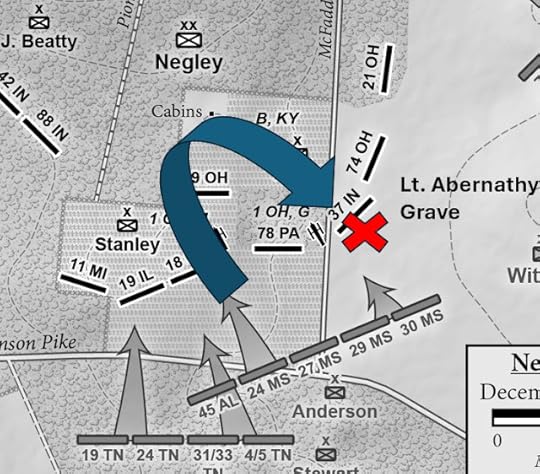
I wish we knew more details. Whether Lieutenant Miller ever was able toreturn the sword to Abernathy’s family or his comrades in the 37thIndiana is lost to history…but having explored its history a bit, I would loveto know if Lieutenant Abernathy’s sword ever made its way into the collector’smarket.
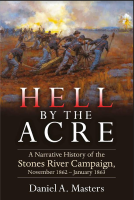 To learn more about the Battle of Stones River, be sure to purchase a copy of my campaign study Hell by the Acre, recently awarded the Richard B. Harwell Award from the Atlanta Civil War Roundtable as best Civil War book of 2024. Available now through Savas Beatie.
To learn more about the Battle of Stones River, be sure to purchase a copy of my campaign study Hell by the Acre, recently awarded the Richard B. Harwell Award from the Atlanta Civil War Roundtable as best Civil War book of 2024. Available now through Savas Beatie.
Sources:
“A CapturedSword,” Macon Beacon (Mississippi), December 29, 1900, pg. 1
Roster of 24thMississippi, Index to Compiled Confederate Military Service Records
M269 CardedRecords Showing Military Service of Soldiers Who Fought in ConfederateOrganizations; entryfor Miller, Robert A., 24th Mississippi
List ofOfficers of 37th Regiment, Indiana Volunteers, Report of theAdjutant General of the State of Indiana
William R.Hunt Letter, Co. K, 37th Indiana, Rare Books and Manuscripts,Indiana Historical Society
Diary ofCaptain Hezekiah Shook, Co. D, 37th Indiana, private collection
Daniel A. Masters's Blog
- Daniel A. Masters's profile
- 1 follower



